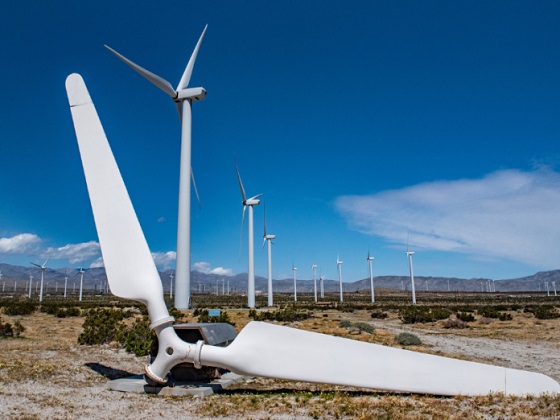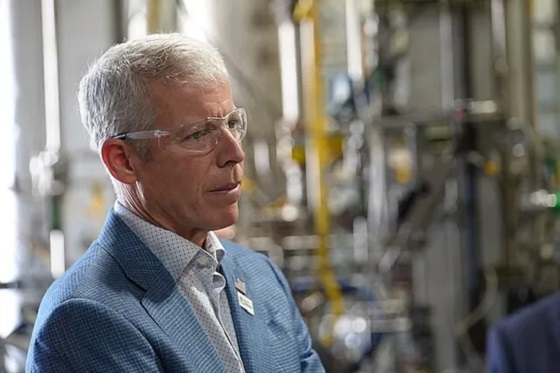Energy
Buckle Up for Summer Blackouts: Wind Is Already Failing Texas in Spring

From Heartland Daily News
By Jason Isaac
When the wind blows too much, natural gas plants are forced to shut down because they can’t underbid wind producers that can bid zero or negative. But when the wind doesn’t blow when it is needed, wind generators can afford the loss of revenue because they earn so much from tax subsidies.
It’s been all quiet on the electric grid front for a few months — but don’t get your hopes up. Over the last month, electricity prices came near the $5000/MWh regulatory cap three separate times because the wind wasn’t blowing enough when the sun went down.
If this sounds familiar, you’re not wrong.
You may hear from the drive-by media that the problem is unseasonably warm temperatures, or that there are a lot of power plants down for maintenance. But high 80s in April and low 90s in May are not unusual, and the Texas grid used to manage these weather changes with no problems. From 2014 to 2016, real-time prices only went over $1000/MWh twice, but it’s happened three times already this year.
If the grid is already on shaky ground, with many weeks to go before blistering triple-digit temperatures shoot electric demand through the roof, all signs are pointing to an unpleasant summer.
The problem with the Texas grid is so simple it’s infuriating: Relying too heavily on unpredictable wind and solar, without enough reliable reserve capacity, means higher volatility — leading to higher prices and increasing need for expensive interventions by ERCOT to avoid outages. This is why your electric bill is going up and up even though wind and solar are supposed to be cheap.
While Texas certainly has a lot of sun, peak solar output almost never aligns with peak electric usage. The Lone Star State also has plenty of wind, but wind generation is wildly unpredictable — by nature. It’s not unusual for a wind generator’s output to swing 60 percentage points or more in a single week.
Take last month, for example. On Tuesday, April 16, electricity prices reached their cap because ERCOT’s day-ahead wind forecast was off by 50%. Five gigawatts of wind we were counting on to power Texas as the sun went down didn’t show up. That was the equivalent of simultaneously shutting down 10 large natural gas units, or all of the state’s nuclear capacity. If the latter occurred, the news media would be up in arms (and rightfully so). But because the culprit was the political darling of both the left and the right, no one heard about it.

ERCOT hasn’t been the best at predicting wind output, and the problem isn’t entirely its fault. Wind veers so wildly between extremes it’s nearly impossible to plan a sustainable grid around its fickleness — yet wind makes up 26% of our generating capacity.
It’s all because lucrative tax breaks and subsidies at the state and federal level, combined with flaws in ERCOT’s market design, make it almost impossible for wind to lose money — and harder than ever for natural gas to compete, even though it’s far more reliable and affordable. When the wind blows too much, natural gas plants are forced to shut down because they can’t underbid wind producers that can bid zero or negative. But when the wind doesn’t blow when it is needed, wind generators can afford the loss of revenue because they earn so much from tax subsidies.
Imagine trying to open a restaurant when your competitor next door is paying its customers to eat there. It’s no wonder natural gas capacity in ERCOT has barely grown over the past decade, and not enough to make up for losses of coal plants, while demand has been steadily increasing.
All those subsidies are hurting our most reliable, affordable energy producers and putting our economy at risk — leaving you and me, the taxpayers on the hook.
While most political issues are far more complex and nuanced than brazen attack ads and headlines would lead you to believe, in this case, it really does boil down to one simple problem.
And it would be easy to solve — if lawmakers are willing to go against the grain of political correctness and set a clear reliability standard for the wind and solar generators that want to connect to our grid.
Unfortunately, that’s a gargantuan “if.”
As a former lawmaker, I understand the pressures our legislators are under to toe the line on alternative energy. Major utilities embracing World Economic Forum- and United Nations-aligned “energy transition” policies that seek to redefine what’s “clean” and what’s “pollution” are making matters worse. And the incessant misinformation from their well-funded lobby that promise rural “economic development” and “cheap energy” sound too good to be true, because they are.
Elected officials don’t serve the lobby. They serve Texans — or, at least, they should.
And Texans want a reliable, affordable grid. They want to not have to worry about losing power in the heat of the summer or the dead of winter. The Legislature must put a stop to these market-distorting subsidies and make reliability, not popularity, the priority for our electric grid.
Gov. Greg Abbott sent a letter on July 6, 2021 to members of the Public Utility Commission of Texas (PUC) directing them to “take immediate action to improve electric reliability across the state.” The second directive was to “Allocate reliability costs to generation resources that cannot guarantee their own availability, such as wind or solar power.” Unfortunately, the PUC hasn’t acted on this directive or even studied it. The costs of scarcity on the grid are estimated to have exceeded $12B in 2023, which is equal to two-thirds of the property tax relief passed in the 88th Legislature, all paid for by ratepayers.
“Unfortunately for Texans, the ERCOT grid is moving from a single grid with gas and coal power plants running efficiently all day to two grids: one for wind and solar and one for expensive backup power that fills in the gaps when there is not enough wind and sun,” says Dr. Brent Bennett, policy director for Life:Powered at the Texas Public Policy Foundation. “Every time these scarcity events occur, whether due to real scarcity or artificial scarcity created by ERCOT’s operating policies, ratepayers are shelling out tens to hundreds of millions of dollars for backup power. It is the most expensive way to operate a grid, and Texans will feel the bite as these costs are absorbed over time.”
The Californication of our grid is unfolding before our eyes. If the Legislature and the PUC don’t act fast, the Texas miracle won’t last.
The Honorable Jason Isaac is CEO of the American Energy Institute and a senior fellow at the Texas Public Policy Foundation. He previously served four terms in the Texas House of Representatives
Business
US Energy Secretary says price of energy determined by politicians and policies


From the Daily Caller News Foundation
During the latest marathon cabinet meeting on Dec. 2, Energy Secretary Chris Wright made news when he told President Donald Trump that “The biggest determinant of the price of energy is politicians, political leaders, and polices — that’s what drives energy prices.”
He’s right about that, and it is why the back-and-forth struggle over federal energy and climate policy plays such a key role in America’s economy and society. Just 10 months into this second Trump presidency, the administration’s policies are already having a profound impact, both at home and abroad.
While the rapid expansion of AI datacenters over the past year is currently being blamed by many for driving up electric costs, power bills were skyrocketing long before that big tech boom began, driven in large part by the policies of the Obama and Biden administration designed to regulate and subsidize an energy transition into reality. As I’ve pointed out here in the past, driving up the costs of all forms of energy to encourage conservation is a central objective of the climate alarm-driven transition, and that part of the green agenda has been highly effective.
Dear Readers:
As a nonprofit, we are dependent on the generosity of our readers.
Please consider making a small donation of any amount here.
Thank you!
President Trump, Wright, and other key appointees like Interior Secretary Doug Burgum and EPA Administrator Lee Zeldin have moved aggressively throughout 2025 to repeal much of that onerous regulatory agenda. The GOP congressional majorities succeeded in phasing out Biden’s costly green energy subsidies as part of the One Big Beautiful Bill Act, which Trump signed into law on July 4. As the federal regulatory structure eases and subsidy costs diminish, it is reasonable to expect a gradual easing of electricity and other energy prices.
This year’s fading out of public fear over climate change and its attendant fright narrative spells bad news for the climate alarm movement. The resulting cracks in the green facade have manifested rapidly in recent weeks.
Climate-focused conflict groups that rely on public fears to drive donations have fallen on hard times. According to a report in the New York Times, the Sierra Club has lost 60 percent of the membership it reported in 2019 and the group’s management team has fallen into infighting over elements of the group’s agenda. Greenpeace is struggling just to stay afloat after losing a huge court judgment for defaming pipeline company Energy Transfer during its efforts to stop the building of the Dakota Access Pipeline.
350.org, an advocacy group founded by Bill McKibben, shut down its U.S. operations in November amid funding woes that had forced planned 25 percent budget cuts for 2025 and 2026. Employees at EDF voted to form their own union after the group went through several rounds of budget cuts and layoffs in recent months.
The fading of climate fears in turn caused the ESG management and investing fad to also fall out of favor, leading to a flood of companies backtracking on green investments and climate commitments. The Net Zero Banking Alliance disbanded after most of America’s big banks – Goldman Sachs, J.P. Morgan Chase, Citigroup, Wells Fargo and others – chose to drop out of its membership.
The EV industry is also struggling. As the Trump White House moves to repeal Biden-era auto mileage requirements, Ford Motor Company is preparing to shut down production of its vaunted F-150 Lightning electric pickup, and Stellantis cancelled plans to roll out a full-size EV truck of its own. Overall EV sales in the U.S. collapsed in October and November following the repeal of the $7,500 per car IRA subsidy effective Sept 30.
The administration’s policy actions have already ended any new leasing for costly and unneeded offshore wind projects in federal waters and have forced the suspension or abandonment of several projects that were already moving ahead. Capital has continued to flow into the solar industry, but even that industry’s ability to expand seems likely to fade once the federal subsidies are fully repealed at the end of 2027.
Truly, public policy matters where energy is concerned. It drives corporate strategies, capital investments, resource development and movement, and ultimately influences the cost of energy in all its forms and products. The speed at which Trump and his key appointees have driven this principle home since Jan. 20 has been truly stunning.
David Blackmon is an energy writer and consultant based in Texas. He spent 40 years in the oil and gas business, where he specialized in public policy and communications.
Energy
A look inside the ‘floatel’ housing B.C.’s LNG workforce

From Resource Works
Innovative housing solution minimizes community impact while supporting the massive labour force needed for the Woodfibre LNG project.
The Woodfibre LNG project — a national leader in Indigenous partnerships and a cornerstone of global energy security — relies on a large construction workforce that drives economic prosperity across the region. For many of these workers, “home” is a ship.
Refitted from a cruise liner into a dedicated accommodation vessel, or “floatel,” this innovative solution houses up to 600 workers near Squamish, B.C., while keeping pressure off local housing and minimizing the project’s community footprint.
These exclusive images, captured a year ago, offer a rare retrospective look inside the original floatel. MV Isabelle X. With a second accommodation ship, the MV Saga X, recently arrived, this photo essay gives a timely, ground-level view of life aboard: individual cabins, a full-service dining hall, recreation spaces and custom laundry facilities. It’s a glimpse into the offshore dormitory that anchors daily life for the crew bringing this vital energy project to completion.

An arcade room is seen on a “floatel” that Woodfibre LNG plans to use to house 600 construction workers at a liquefied natural gas export facility being built near Squamish, during a media tour in Vancouver, on Thursday, May 9, 2024. The ship arrived in B.C. waters in January after a 40-day journey from Estonia, where it had sheltered Ukrainian refugees, but the District of Squamish council voted three to four against a one-year permit for its use last week.

A dining area is seen on a “floatel” that Woodfibre LNG plans to use to house 600 construction workers at a liquefied natural gas export facility being built near Squamish, during a media tour in Vancouver, on Thursday, May 9, 2024. The ship arrived in B.C. waters in January after a 40-day journey from Estonia, where it had sheltered Ukrainian refugees, but the District of Squamish council voted three to four against a one-year permit for its use last week.

A cabin is seen on a “floatel” that Woodfibre LNG plans to use to house 600 construction workers at a liquefied natural gas export facility being built near Squamish, during a media tour in Vancouver, on Thursday, May 9, 2024. The ship arrived in B.C. waters in January after a 40-day journey from Estonia, where it had sheltered Ukrainian refugees, but the District of Squamish council voted three to four against a one-year permit for its use last week.

Bridgemans Services Group president Brian Grange stands at the stern on a renovated cruise ship known as a “floatel” that Woodfibre LNG plans to use to house 600 construction workers at a liquefied natural gas export facility being built near Squamish, during a media tour in Vancouver, on Thursday, May 9, 2024. The ship arrived in B.C. waters in January after a 40-day journey from Estonia, where it had sheltered Ukrainian refugees, but the District of Squamish council voted three to four against a one-year permit for its use last week.

A custom built heat pump unit that allows the ship to avoid using diesel while docked and at anchor is seen on a “floatel” that Woodfibre LNG plans to use to house 600 construction workers at a liquefied natural gas export facility being built near Squamish, during a media tour in Vancouver, on Thursday, May 9, 2024. The ship arrived in B.C. waters in January after a 40-day journey from Estonia, where it had sheltered Ukrainian refugees, but the District of Squamish council voted three to four against a one-year permit for its use last week.

The main entry and exit area for workers is seen on a “floatel” that Woodfibre LNG plans to use to house 600 construction workers at a liquefied natural gas export facility being built near Squamish, during a media tour in Vancouver, on Thursday, May 9, 2024. The ship arrived in B.C. waters in January after a 40-day journey from Estonia, where it had sheltered Ukrainian refugees, but the District of Squamish council voted three to four against a one-year permit for its use last week.

A renovated cruise ship known as a “floatel” that Woodfibre LNG plans to use to house 600 construction workers at a liquefied natural gas export facility being built near Squamish, is seen at anchor in the harbour in Vancouver, on Thursday, May 9, 2024. The ship arrived in B.C. waters in January after a 40-day journey from Estonia, where it had sheltered Ukrainian refugees, but the District of Squamish council voted three to four against a one-year permit for its use last week.

A tugboat and water taxi are seen docked at a renovated cruise ship known as a “floatel” that Woodfibre LNG plans to use to house 600 construction workers at a liquefied natural gas export facility being built near Squamish, at anchor in the harbour in Vancouver, on Thursday, May 9, 2024. The ship arrived in B.C. waters in January after a 40-day journey from Estonia, where it had sheltered Ukrainian refugees, but the District of Squamish council voted three to four against a one-year permit for its use last week.
All photos credited to THE CANADIAN PRESS/Darryl Dyck
Resource Works News
-

 MAiD2 days ago
MAiD2 days agoFrom Exception to Routine. Why Canada’s State-Assisted Suicide Regime Demands a Human-Rights Review
-

 Business2 days ago
Business2 days agoCarney government should privatize airports—then open airline industry to competition
-

 Alberta2 days ago
Alberta2 days agoCarney’s pipeline deal hits a wall in B.C.
-

 Alberta2 days ago
Alberta2 days agoAlberta Sports Hall of Fame Announces Class of 2026 Inductees
-

 Censorship Industrial Complex1 day ago
Censorship Industrial Complex1 day agoConservative MP Leslyn Lewis slams Liberal plan targeting religious exemption in hate speech bil
-

 Business2 days ago
Business2 days agoWhat’s Going On With Global Affairs Canada and Their $392 Million Spending Trip to Brazil?
-

 Business2 days ago
Business2 days agoIs Carney Falling Into The Same Fiscal Traps As Trudeau?
-

 Energy2 days ago
Energy2 days agoCanada following Europe’s stumble by ignoring energy reality






